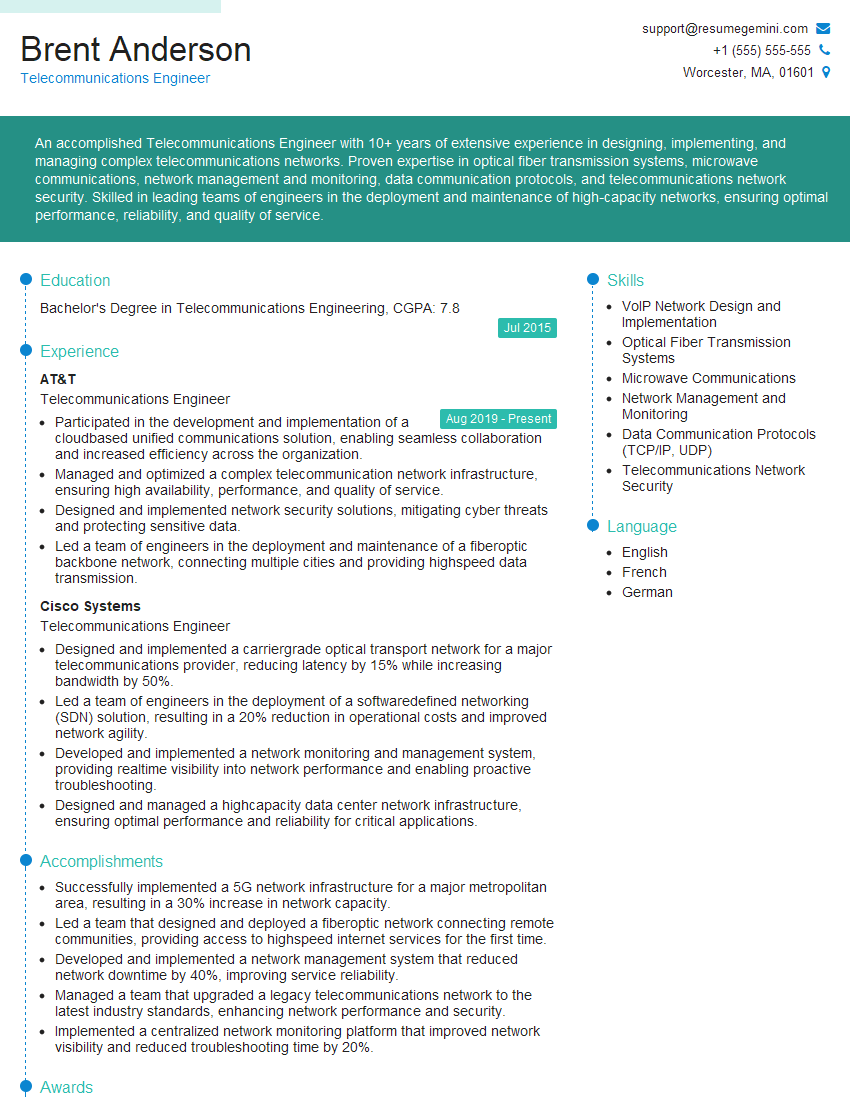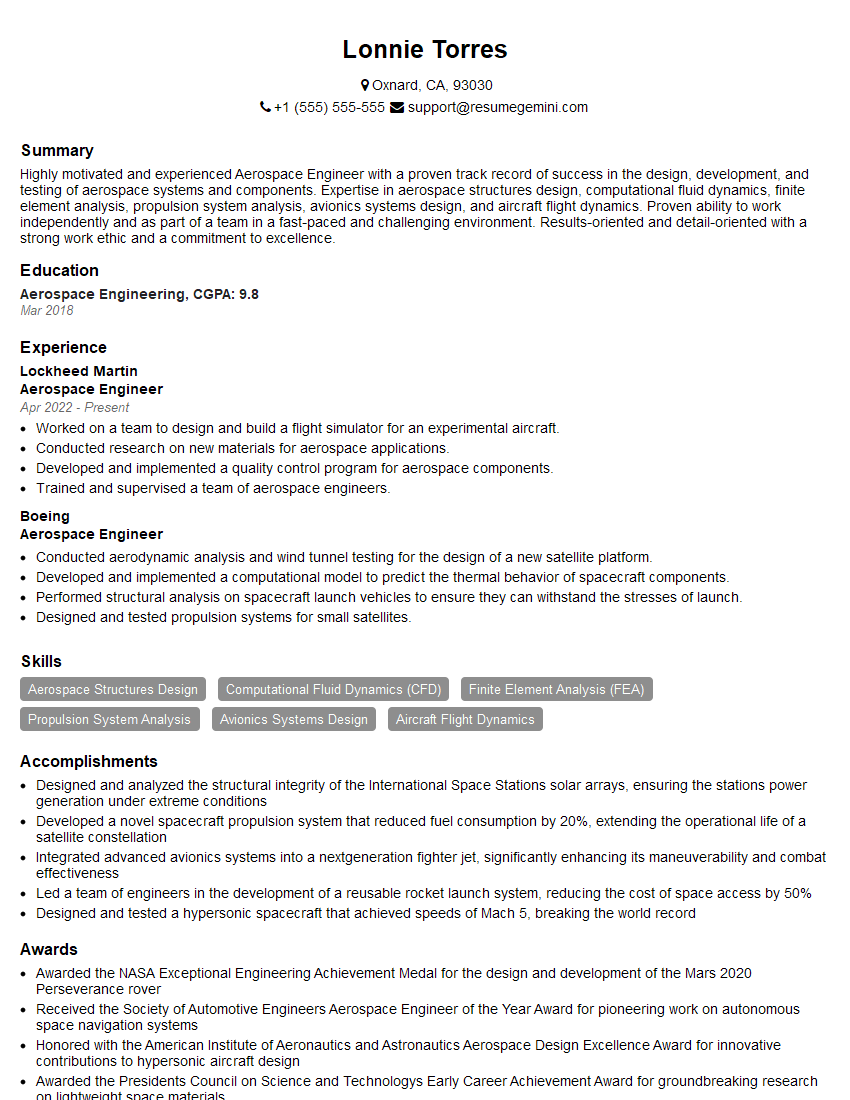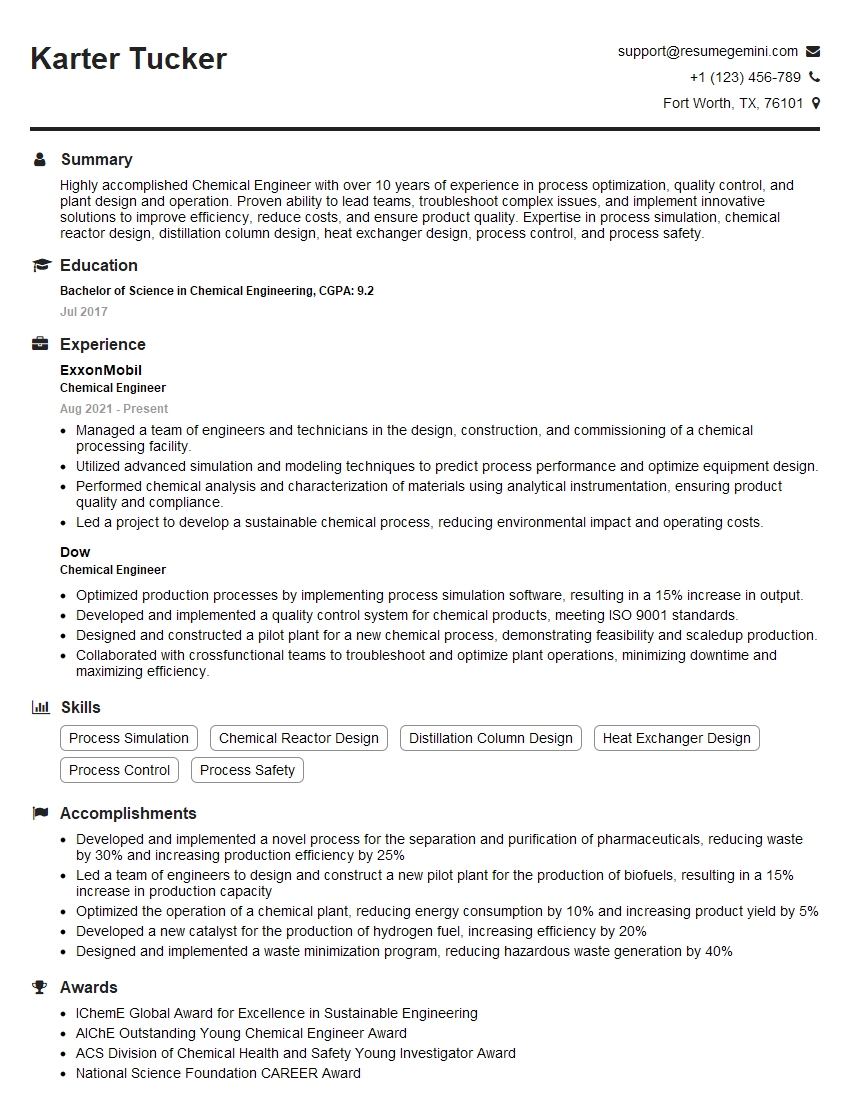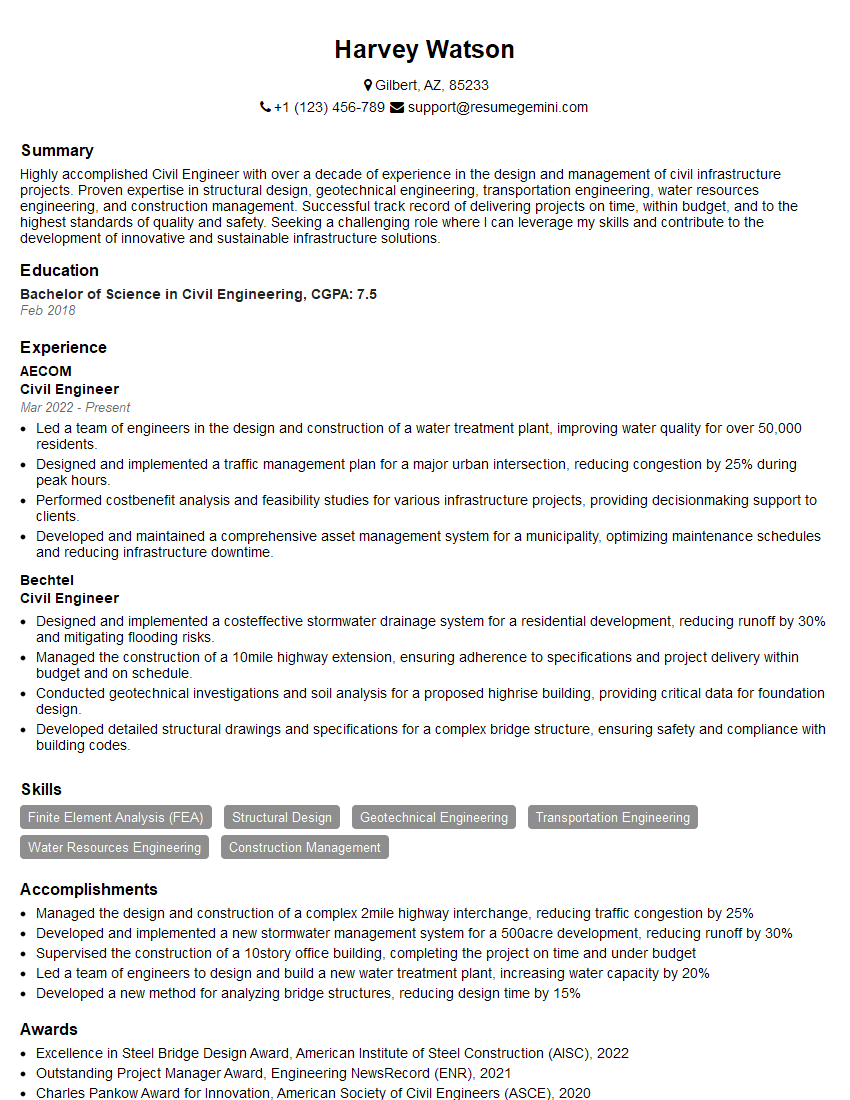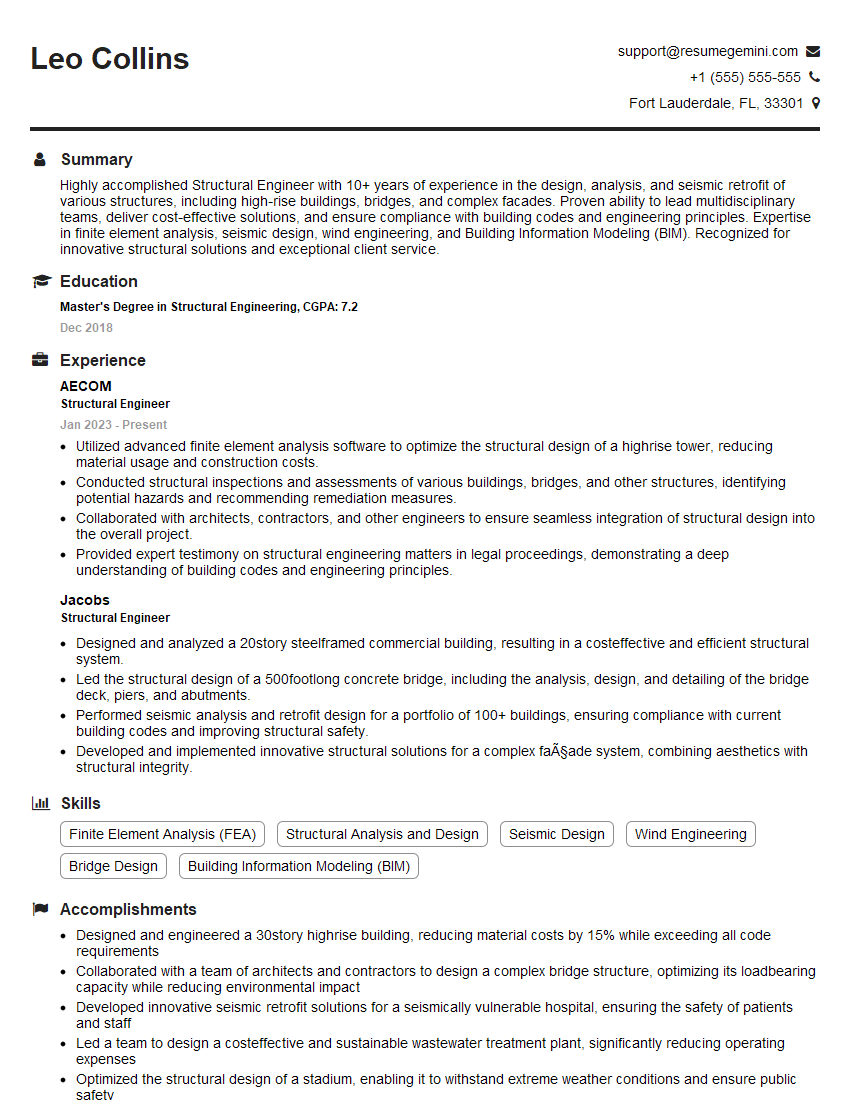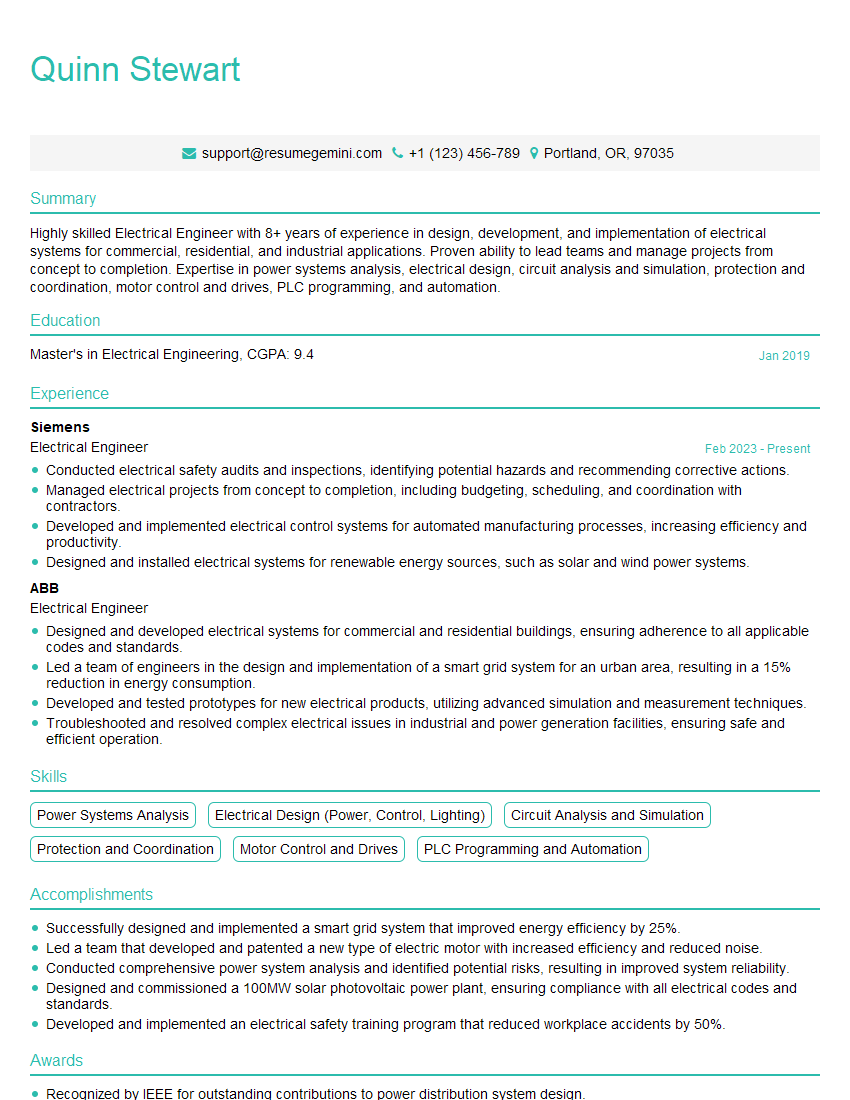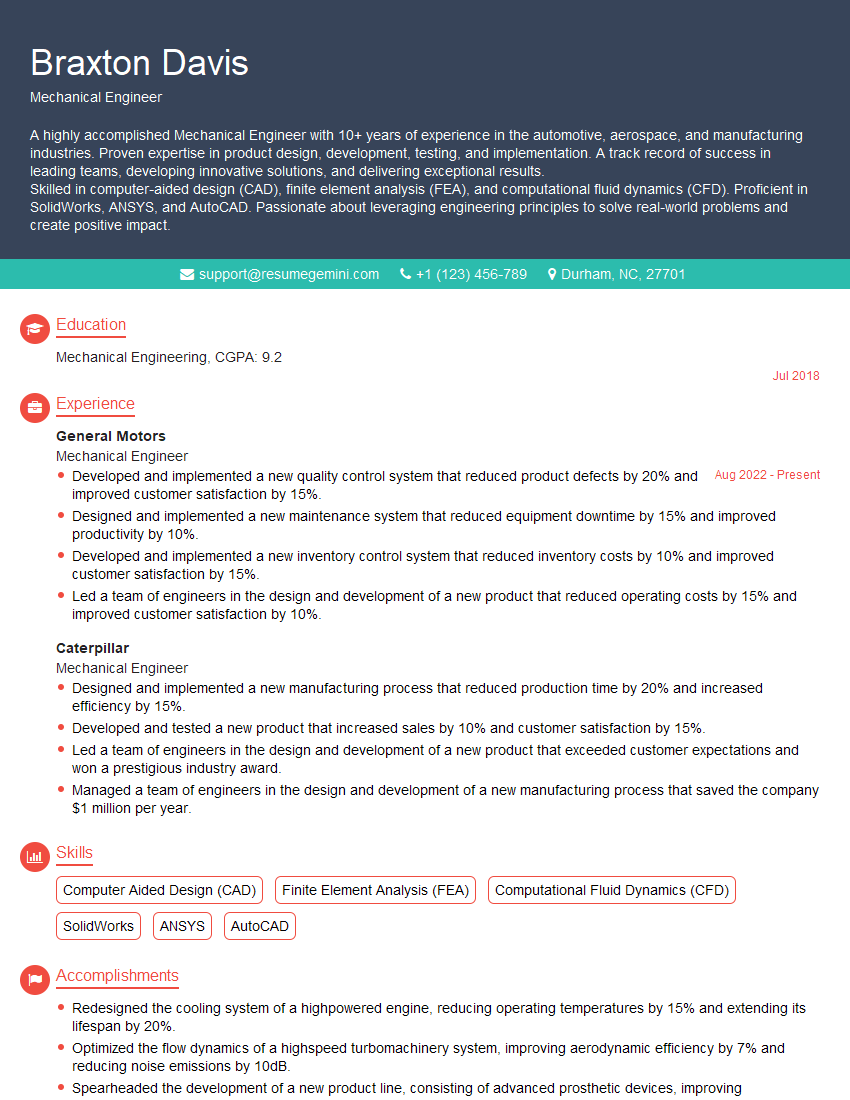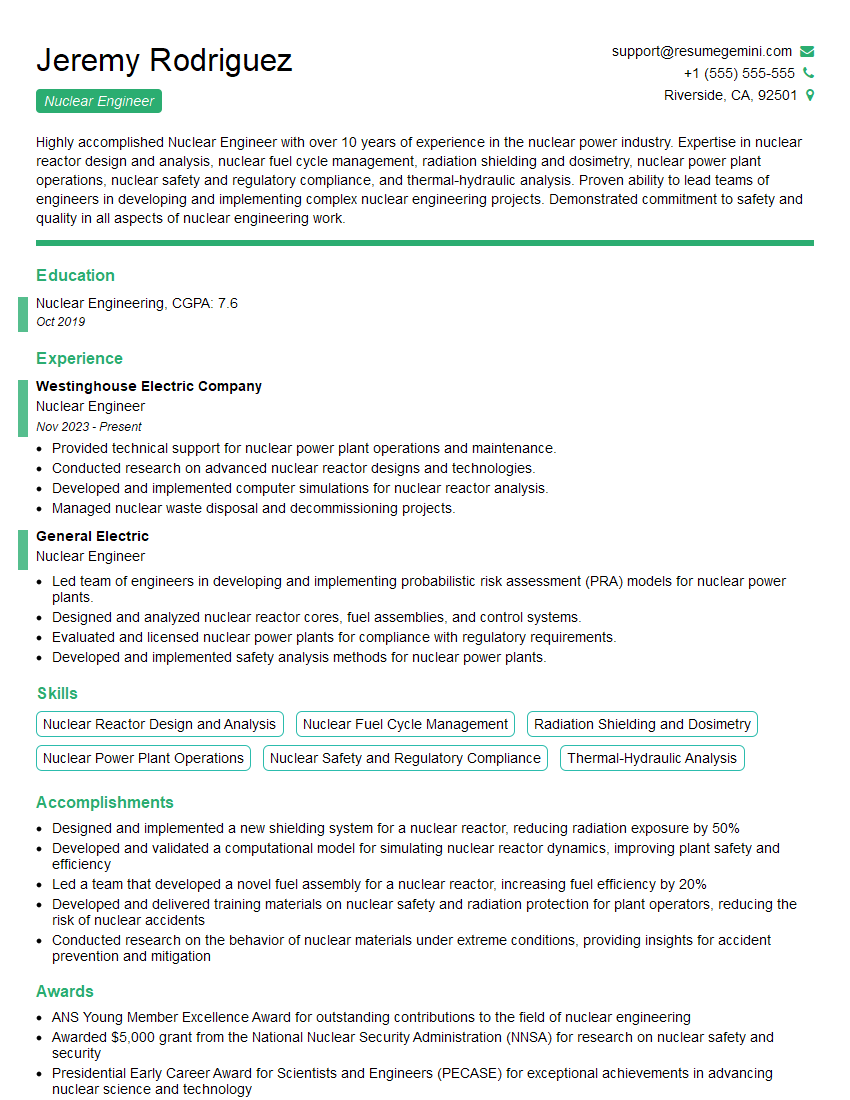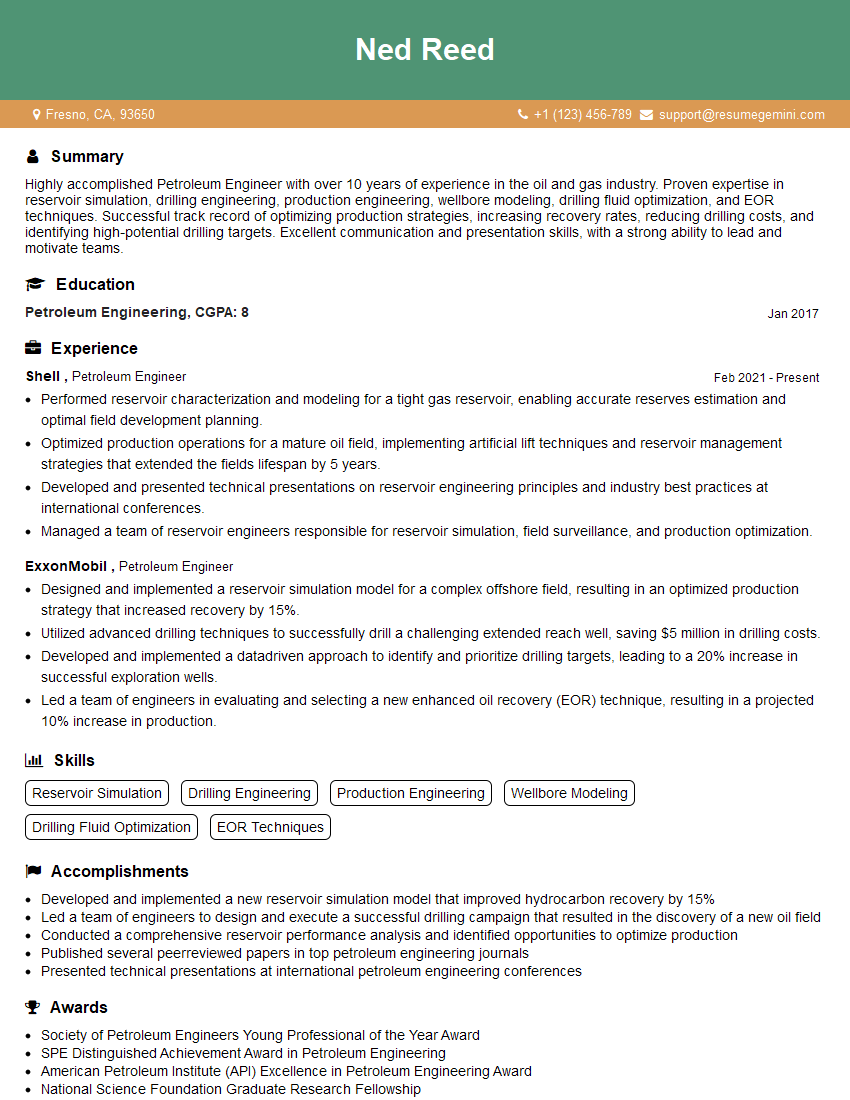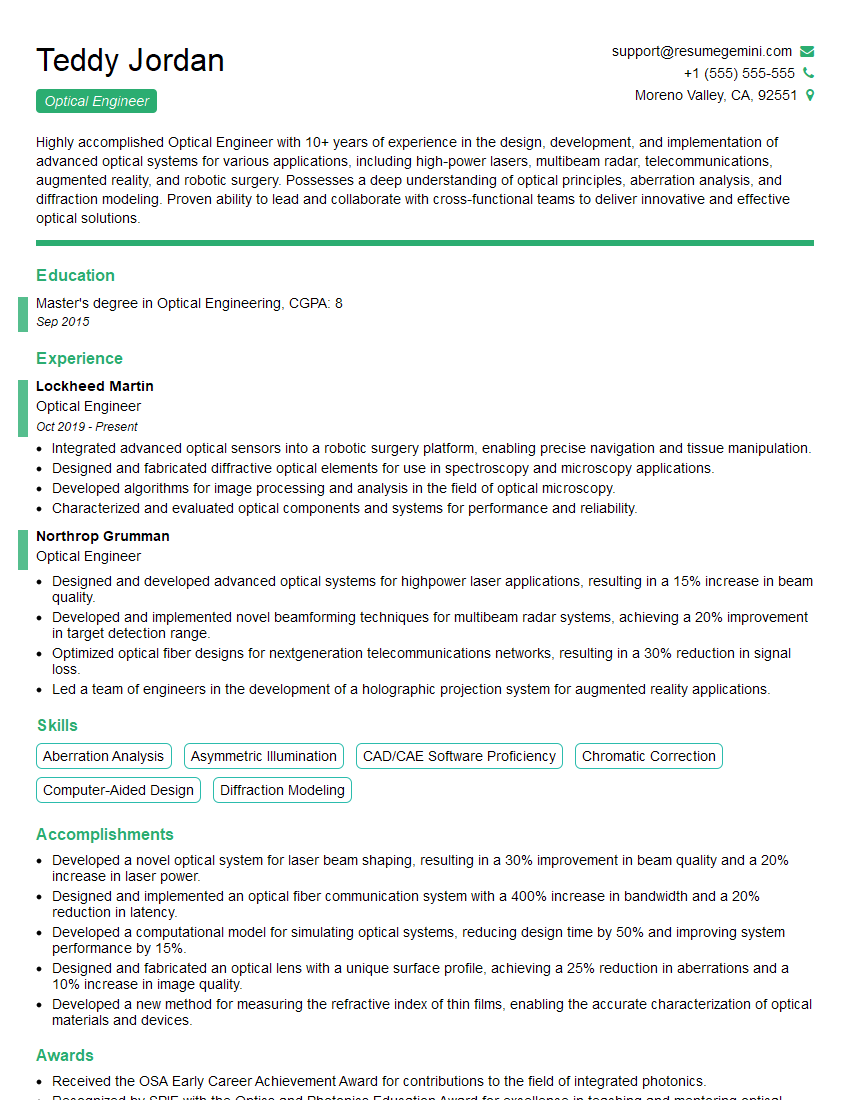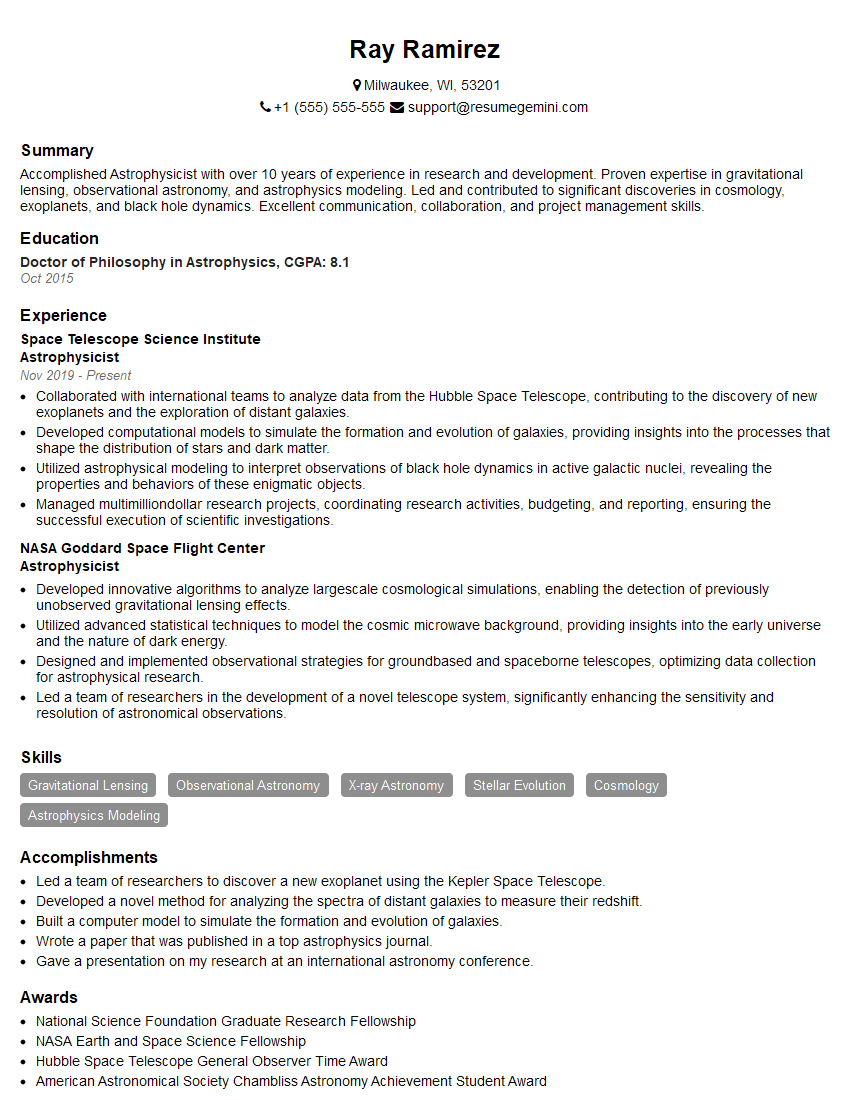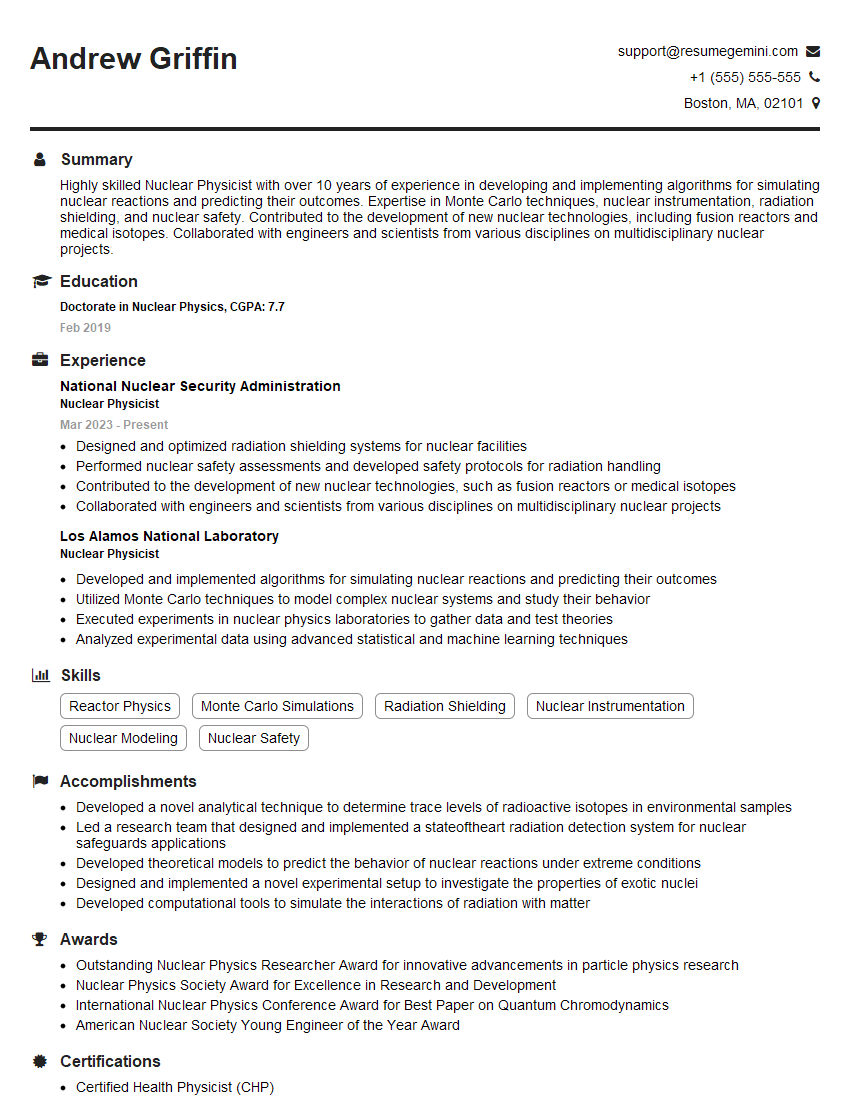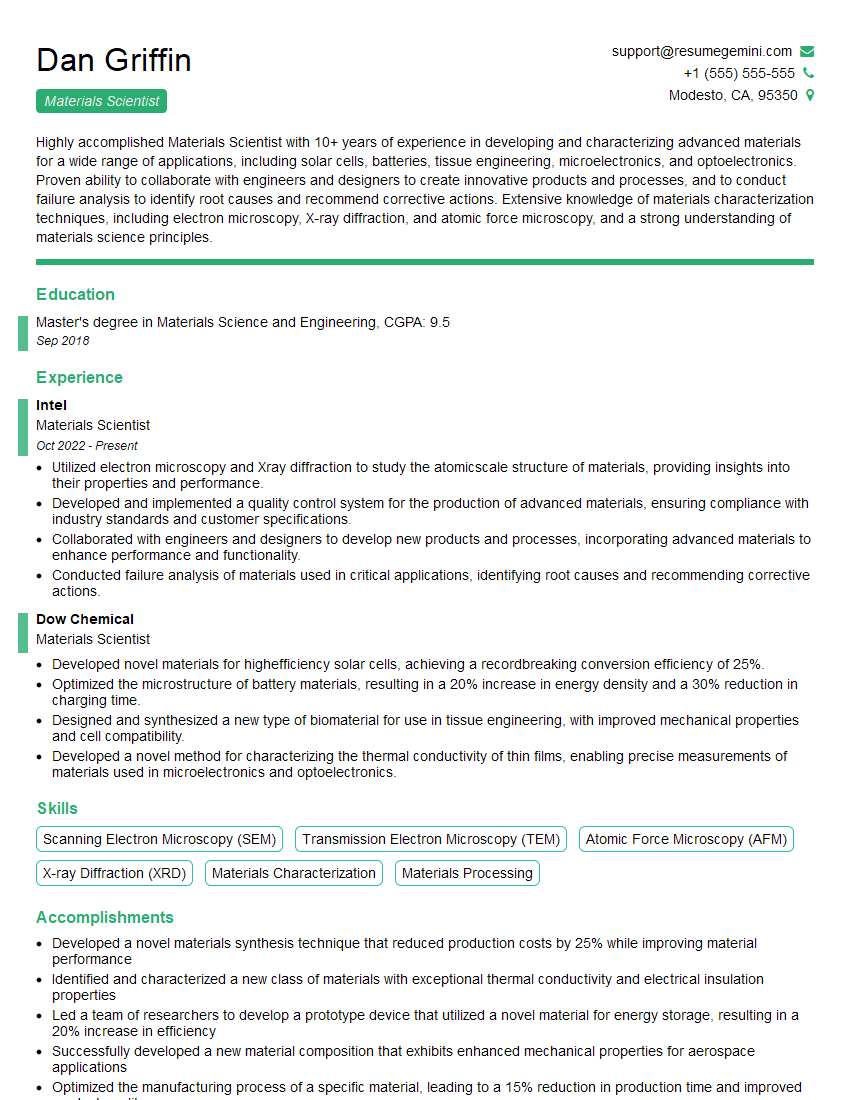Interviews are opportunities to demonstrate your expertise, and this guide is here to help you shine. Explore the essential Physics and Engineering interview questions that employers frequently ask, paired with strategies for crafting responses that set you apart from the competition.
Questions Asked in Physics and Engineering Interview
Q 1. Explain the principles of Newtonian mechanics.
Newtonian mechanics, also known as classical mechanics, describes the motion of macroscopic objects and systems under the influence of forces. It’s based on three fundamental laws:
- Newton’s First Law (Inertia): An object at rest stays at rest and an object in motion stays in motion with the same speed and in the same direction unless acted upon by an unbalanced force. Think of a hockey puck gliding across frictionless ice – it would continue indefinitely.
- Newton’s Second Law (F=ma): The acceleration of an object is directly proportional to the net force acting on the object, is in the same direction as the net force, and is inversely proportional to the mass of the object. This law forms the basis for calculating forces and accelerations in many engineering problems. For example, designing a car requires careful consideration of how engine force translates to acceleration based on the car’s mass.
- Newton’s Third Law (Action-Reaction): For every action, there is an equal and opposite reaction. When you jump, you push down on the Earth, and the Earth pushes back on you with an equal force, propelling you upwards. Rocket propulsion is a prime example of this.
Newtonian mechanics provides a powerful framework for understanding and predicting the motion of objects in many everyday situations, forming the foundation for much of engineering design.
Q 2. Describe the different types of energy and their conversions.
Energy exists in many forms, and these forms can be interconverted. Key types include:
- Kinetic Energy: Energy of motion. A moving car possesses kinetic energy, proportional to its mass and the square of its velocity (KE = 1/2mv²).
- Potential Energy: Stored energy due to position or configuration. A book held above the ground has gravitational potential energy, which is converted to kinetic energy as it falls. A stretched spring possesses elastic potential energy.
- Thermal Energy (Heat): Energy associated with the random motion of atoms and molecules. Burning fuel converts chemical energy into thermal energy.
- Chemical Energy: Energy stored in the bonds of molecules. This is released during chemical reactions, such as combustion or metabolism.
- Nuclear Energy: Energy stored in the nucleus of an atom. Nuclear fission and fusion release enormous amounts of energy.
- Electrical Energy: Energy associated with the flow of electric charge. Powering a lightbulb converts electrical energy into light and heat.
Energy conversions are ubiquitous. A hydroelectric dam converts gravitational potential energy (water held high) into kinetic energy (flowing water) and then into electrical energy (generators). Internal combustion engines convert chemical energy (fuel) into thermal energy and then into mechanical energy (motion).
Q 3. What are the laws of thermodynamics and their applications?
The four laws of thermodynamics govern energy and entropy in physical systems:
- Zeroth Law: If two thermodynamic systems are each in thermal equilibrium with a third, then they are in thermal equilibrium with each other. This establishes the concept of temperature.
- First Law (Conservation of Energy): Energy cannot be created or destroyed, only transformed from one form to another. The total energy of an isolated system remains constant.
- Second Law (Entropy Increase): The total entropy of an isolated system can only increase over time, or remain constant in ideal cases where the system is in a steady state or undergoing a reversible process. This implies that processes tend towards disorder.
- Third Law: The entropy of a perfect crystal approaches zero as its temperature approaches absolute zero (0 Kelvin). It’s impossible to reach absolute zero in a finite number of steps.
Applications are widespread: power plants (converting thermal energy to mechanical energy), refrigeration (transferring heat from a cold space to a warm space), and engine design (optimizing efficiency by minimizing energy loss).
Q 4. Explain the concept of entropy.
Entropy is a measure of disorder or randomness in a system. A highly ordered system (like a neatly stacked deck of cards) has low entropy, while a disordered system (like the same deck after thorough shuffling) has high entropy. The second law of thermodynamics states that the entropy of an isolated system never decreases. Think of a messy room – it tends to get messier on its own, not cleaner, unless external work (cleaning) is done.
In a microscopic view, entropy reflects the number of possible microstates corresponding to a given macrostate. A macrostate describes the overall properties of a system (like temperature and pressure), while a microstate describes the specific arrangement of its constituents (like the positions and velocities of all molecules). A higher number of microstates equates to higher entropy.
Entropy is crucial in chemistry (predicting the spontaneity of reactions), thermodynamics (analyzing energy efficiency), and information theory (quantifying information).
Q 5. Describe different types of mechanical stress and strain.
Mechanical stress is the force per unit area acting on a material, while strain is the resulting deformation. Types include:
- Tensile Stress/Strain: Pulling force causing elongation. Imagine stretching a rubber band.
- Compressive Stress/Strain: Pushing force causing shortening. Think of a column supporting a load.
- Shear Stress/Strain: Force parallel to the surface causing deformation. Imagine sliding one layer of a deck of cards over another.
- Torsional Stress/Strain: Twisting force causing angular deformation. Think of twisting a metal rod.
- Bending Stress/Strain: Combination of tensile and compressive stress due to bending. Think of bending a metal beam.
Understanding these stresses and strains is fundamental to structural engineering, material science, and mechanical design. Designing a bridge requires careful calculation of the stresses on the supporting beams to ensure they don’t fail under load.
Q 6. What are the fundamental principles of fluid mechanics?
Fluid mechanics studies the behavior of fluids (liquids and gases) at rest and in motion. Fundamental principles include:
- Conservation of Mass: Mass is neither created nor destroyed in a fluid flow. The mass flow rate into a control volume must equal the mass flow rate out.
- Conservation of Momentum (Newton’s Second Law): The net force acting on a fluid element is equal to the rate of change of its momentum. This leads to equations governing fluid motion.
- Conservation of Energy (Bernoulli’s Equation): Relates pressure, velocity, and elevation in a fluid flow. For an inviscid, incompressible fluid, the sum of pressure energy, kinetic energy, and potential energy remains constant along a streamline.
These principles are used to analyze diverse phenomena, from the flow of blood in arteries to the design of aircraft wings and pipelines.
Q 7. Explain Bernoulli’s principle and its applications.
Bernoulli’s principle states that an increase in the speed of a fluid occurs simultaneously with a decrease in static pressure or a decrease in the fluid’s potential energy. This is a consequence of the conservation of energy for flowing fluids.
Imagine a fluid flowing through a pipe with a constriction. The fluid speeds up in the constriction because the same amount of fluid must pass through the narrower section in the same amount of time. Because the fluid is moving faster in the constriction, its kinetic energy increases, resulting in a decrease in its pressure.
Applications abound: airplane wings (lift is generated by the faster airflow over the curved upper surface), carburetors (mixing air and fuel), and venturi meters (measuring flow rate).
Q 8. Describe different types of heat transfer.
Heat transfer is the movement of thermal energy from a region of higher temperature to a region of lower temperature. This occurs through three primary mechanisms:
- Conduction: Heat transfer through direct contact. Imagine holding a hot cup of coffee – the heat transfers directly from the cup to your hand.
- Convection: Heat transfer through the movement of fluids (liquids or gases). Think of boiling water; the hot water rises, and cooler water sinks, creating a convection current. This is also how radiators heat a room.
- Radiation: Heat transfer through electromagnetic waves. The sun warms the Earth through radiation; no physical medium is needed.
Understanding these methods is crucial in various engineering applications, such as designing efficient heating and cooling systems, thermal insulation in buildings, and managing heat dissipation in electronics.
Q 9. Explain the concept of electromagnetic waves.
Electromagnetic waves are disturbances that propagate through space by the interplay of oscillating electric and magnetic fields. They don’t require a medium to travel, unlike sound waves. These waves travel at the speed of light (approximately 3 x 108 m/s in a vacuum) and exhibit wave-particle duality, meaning they possess properties of both waves and particles (photons).
The electromagnetic spectrum encompasses a vast range of wavelengths, including radio waves, microwaves, infrared radiation, visible light, ultraviolet radiation, X-rays, and gamma rays. Each type of radiation has different properties and applications, from radio communication to medical imaging.
A simple example is visible light. Our eyes detect a small portion of the electromagnetic spectrum. Different wavelengths within this visible spectrum appear as different colors.
Q 10. What are Maxwell’s equations and their significance?
Maxwell’s equations are a set of four fundamental equations that describe how electric and magnetic fields behave and interact. They are the cornerstone of classical electromagnetism and predict the existence of electromagnetic waves.
- Gauss’s law for electricity: Relates the electric field to electric charge distribution.
- Gauss’s law for magnetism: States that there are no magnetic monopoles (isolated north or south poles).
- Faraday’s law of induction: Describes how a changing magnetic field creates an electric field.
- Ampère-Maxwell’s law: Shows how electric currents and changing electric fields create a magnetic field.
Their significance lies in unifying electricity and magnetism, explaining phenomena like light, and forming the basis for technologies like radio, television, and radar. They’re essential for understanding and designing electrical and electronic devices.
Q 11. Explain the principles of quantum mechanics.
Quantum mechanics is a fundamental theory in physics that describes the physical properties of nature at the scale of atoms and subatomic particles. It differs significantly from classical mechanics, which accurately describes macroscopic objects.
Key principles include:
- Quantization: Energy, momentum, and other properties are not continuous but exist in discrete units called quanta.
- Wave-particle duality: Particles like electrons can exhibit wave-like behavior, and vice versa.
- Heisenberg’s uncertainty principle: It’s impossible to simultaneously know both the position and momentum of a particle with perfect accuracy.
- Probability and wave functions: The behavior of quantum particles is described by probability amplitudes represented by wave functions.
Quantum mechanics is crucial for understanding the behavior of atoms, molecules, and solids, and it underpins technologies like lasers, transistors, and nuclear magnetic resonance imaging (MRI).
Q 12. Describe the difference between AC and DC circuits.
The primary difference between AC (Alternating Current) and DC (Direct Current) circuits lies in the direction of electron flow:
- DC: Electrons flow in one direction consistently. Think of a battery – the electrons flow from the negative terminal to the positive terminal.
- AC: Electrons periodically reverse direction, oscillating back and forth. Household electricity is AC, with the electrons changing direction 50 or 60 times per second (depending on the country’s standard).
AC is easier to generate and transmit over long distances due to the ability to efficiently step up and down voltage using transformers. DC is generally used in low-voltage applications like electronics and batteries.
Q 13. Explain Ohm’s law and its limitations.
Ohm’s law states that the current (I) flowing through a conductor is directly proportional to the voltage (V) across it and inversely proportional to its resistance (R): V = IR
This law is fundamental in circuit analysis, allowing for straightforward calculations of voltage, current, and resistance. However, it has limitations:
- Non-Ohmic materials: Ohm’s law only applies to materials where resistance remains constant over a range of voltages and currents (ohmic materials). Many materials, like semiconductors and diodes, exhibit non-linear behavior.
- Temperature effects: Resistance changes with temperature, so Ohm’s law is only accurate at a constant temperature.
- High frequencies: At very high frequencies, the effects of inductance and capacitance become significant and Ohm’s law is no longer an adequate approximation.
Despite its limitations, Ohm’s law provides a valuable approximation for many practical circuits under normal operating conditions.
Q 14. What are Kirchhoff’s laws and how are they applied?
Kirchhoff’s laws are fundamental principles used in circuit analysis to solve complex circuits. They consist of two laws:
- Kirchhoff’s Current Law (KCL): The sum of currents entering a node (junction) is equal to the sum of currents leaving that node. This reflects the conservation of charge – charge cannot accumulate at a node.
- Kirchhoff’s Voltage Law (KVL): The sum of voltages around any closed loop in a circuit is zero. This reflects the conservation of energy – no energy is gained or lost in a closed loop.
These laws are applied by setting up equations based on the circuit’s topology and using them to solve for unknown voltages and currents. They’re essential tools for electrical engineers in designing and analyzing circuits, from simple resistor networks to complex integrated circuits.
Q 15. Describe different types of semiconductor devices.
Semiconductor devices are the building blocks of modern electronics. They utilize materials with electrical conductivity between that of a conductor (like copper) and an insulator (like rubber). This intermediate conductivity allows for precise control of electrical current, forming the basis for transistors, diodes, and integrated circuits.
- Diodes: These are essentially one-way valves for electricity. They allow current to flow easily in one direction but offer high resistance in the opposite direction. A common example is a rectifier, used to convert alternating current (AC) to direct current (DC) in power supplies.
- Transistors: These are the fundamental building blocks of integrated circuits. They act as electronic switches or amplifiers, controlling larger currents with smaller control signals. Transistors are ubiquitous in computers, smartphones, and countless other electronic devices.
- Integrated Circuits (ICs): These are miniature circuits containing millions or even billions of transistors, diodes, and other components on a single chip of silicon. Microprocessors, memory chips, and other complex electronic functions are implemented using ICs.
- Field-Effect Transistors (FETs): These are a type of transistor where the current is controlled by an electric field applied to a gate terminal. FETs are widely used in digital logic circuits and analog amplifiers, known for their low power consumption.
- Bipolar Junction Transistors (BJTs): These are another type of transistor where current flows between two junctions of different semiconductor types. BJTs are often found in high-power applications and analog circuitry.
The choice of semiconductor device depends on the specific application, considering factors like power consumption, switching speed, and cost.
Career Expert Tips:
- Ace those interviews! Prepare effectively by reviewing the Top 50 Most Common Interview Questions on ResumeGemini.
- Navigate your job search with confidence! Explore a wide range of Career Tips on ResumeGemini. Learn about common challenges and recommendations to overcome them.
- Craft the perfect resume! Master the Art of Resume Writing with ResumeGemini’s guide. Showcase your unique qualifications and achievements effectively.
- Don’t miss out on holiday savings! Build your dream resume with ResumeGemini’s ATS optimized templates.
Q 16. Explain the working principle of a transistor.
A transistor acts as an electronic switch or amplifier. Its operation relies on controlling the flow of current between two terminals (the collector and emitter) using a small current or voltage applied to a third terminal (the base in a BJT, or the gate in a FET).
Imagine a water faucet: the base/gate acts like the handle, controlling the flow of water (current) between the tap and the spout (collector and emitter). A small turn of the handle (small control signal) can control a much larger flow of water (larger current).
In a Bipolar Junction Transistor (BJT), a small current injected into the base modulates the much larger current flowing between the collector and emitter. In a Field-Effect Transistor (FET), a voltage applied to the gate creates an electric field that controls the current flow between the source and drain.
This ability to control a large current with a small signal makes transistors incredibly versatile. They’re essential for amplification in audio systems, switching in digital logic circuits, and numerous other functions in electronics.
Q 17. Describe the process of signal transduction.
Signal transduction is the process of converting one type of signal or stimulus into another. It’s a fundamental process in biology, allowing cells and organisms to respond to their environment. Imagine it as a chain of events, where a signal triggers a series of reactions, ultimately leading to a cellular response.
For example, consider your sense of touch. When you touch something hot, heat stimulates sensory neurons in your skin. This physical stimulus (heat) is converted into an electrical signal by the neurons. This electrical signal is then transmitted along the nerve fibers to the brain, where it’s interpreted as a sensation of heat. This entire process, from the heat stimulus to the brain’s interpretation, is signal transduction.
Key steps in signal transduction often involve:
- Reception: The cell detects a signaling molecule (ligand).
- Transduction: The signal is converted into a different form, often involving a series of intracellular signaling events.
- Response: The cell reacts to the signal, often by changing its behavior or gene expression.
Signal transduction pathways are crucial for a vast range of biological processes, including cell growth, differentiation, immune responses, and many others. Disruptions in these pathways are frequently implicated in diseases.
Q 18. What are the different types of materials used in engineering?
Engineering utilizes a wide range of materials, each with its unique properties. The choice of material is crucial in determining the performance, cost, and lifespan of an engineered system. Materials are broadly categorized as follows:
- Metals: Iron, steel, aluminum, copper, etc. These are strong, ductile (can be easily deformed), and have good conductivity. Used extensively in construction, automotive, and aerospace industries.
- Ceramics: Clay, porcelain, glass, etc. These are hard, brittle, and resistant to high temperatures. Applications include heat shields, insulators, and cutting tools.
- Polymers: Plastics, rubbers, etc. These are lightweight, flexible, and can be molded into various shapes. Used in packaging, textiles, and many consumer products. Examples include polyethylene (plastic bags), nylon (clothing), and silicone (sealants).
- Composites: Materials made by combining two or more different materials to achieve enhanced properties. For instance, fiberglass (glass fibers embedded in a polymer matrix) is strong and lightweight, used in boats and airplanes. Carbon fiber composites offer exceptional strength-to-weight ratios and are used in high-performance applications.
- Semiconductors: Silicon, germanium, etc. These materials have electrical conductivity between conductors and insulators, essential for electronic devices.
Material selection is a critical aspect of engineering design, requiring a detailed understanding of material properties and their relationship to the intended application.
Q 19. Explain the concept of material strength and fatigue.
Material strength refers to a material’s ability to withstand external forces without breaking or deforming permanently. It’s often expressed as tensile strength (resistance to stretching), compressive strength (resistance to squeezing), and shear strength (resistance to sliding forces).
Fatigue, on the other hand, is the weakening of a material due to repeated cycles of stress. Imagine bending a paper clip back and forth repeatedly – eventually, it’ll break, even though a single bend wouldn’t have caused failure. This is fatigue failure. The repeated stress creates microscopic cracks that gradually propagate until catastrophic failure occurs.
Fatigue is a significant concern in engineering design, especially in components subjected to cyclic loading, such as aircraft wings, bridges, and engine parts. Engineers use techniques like fatigue testing to determine a material’s fatigue life and design components with sufficient safety margins to prevent fatigue failures.
Q 20. Describe the different types of structural analysis techniques.
Structural analysis techniques are used to determine the behavior of structures under various loads. These techniques help engineers design safe and efficient structures. Common methods include:
- Static Analysis: This analyzes structures under constant loads, ignoring the effects of time-varying forces. For example, determining the stresses in a bridge under its own weight and the weight of vehicles.
- Dynamic Analysis: This considers time-varying loads like wind gusts, earthquakes, or moving vehicles. This is essential for designing structures resistant to dynamic effects.
- Linear Analysis: Assumes a linear relationship between loads and structural responses. Simpler but often accurate for smaller loads.
- Nonlinear Analysis: Accounts for nonlinear material behavior or large deformations, required for high-load scenarios or complex material properties.
- Experimental Analysis: Physical testing of structures or components to verify analytical predictions. This involves applying loads and measuring the responses directly.
- Numerical Methods (like Finite Element Analysis): Use computer programs to solve complex structural problems by breaking down the structure into smaller elements.
The choice of technique depends on factors like the complexity of the structure, the type of loading, and the desired accuracy.
Q 21. Explain the concept of finite element analysis (FEA).
Finite Element Analysis (FEA) is a powerful computational technique used to predict the behavior of structures and components under various loads. It works by dividing a complex structure into smaller, simpler elements (like tiny pieces of a puzzle). These elements are interconnected at nodes, and the behavior of each element is analyzed individually. These individual analyses are then combined to approximate the overall behavior of the structure.
Think of it like building a model out of Lego bricks. Each brick is an element, and the connections are nodes. By understanding how each brick behaves under force, you can get a good idea of how the entire structure will behave.
FEA software solves a system of equations to calculate stresses, strains, displacements, and other properties at each element and node. This allows engineers to analyze structures for strength, stiffness, and fatigue life. FEA is widely used across various engineering disciplines, from aerospace and automotive to biomedical and civil engineering.
Example: A FEA simulation might be used to analyze the stress distribution in a car chassis during a crash test, helping to optimize the design for passenger safety.
Q 22. What are the different types of manufacturing processes?
Manufacturing processes can be broadly categorized into several types, each with its own strengths and weaknesses. The choice depends on factors like material properties, desired product precision, production volume, and cost.
- Subtractive Manufacturing: This involves removing material from a larger block to create the final product. Examples include machining (milling, turning, drilling), cutting (laser cutting, water jet cutting), and grinding. Think of sculpting – you start with a large piece of clay and remove material to create a shape.
- Additive Manufacturing (3D Printing): This builds up a three-dimensional object layer by layer from a digital design. Common methods include fused deposition modeling (FDM), stereolithography (SLA), and selective laser melting (SLM). This is like building a brick wall, adding one brick at a time.
- Formative Manufacturing: This involves shaping a material into the desired form without removing material. Examples include casting (pouring molten material into a mold), forging (shaping metal using compressive forces), and extrusion (forcing material through a die to create a continuous shape). Think of molding clay or making pasta.
- Joining Processes: These methods combine different parts or materials. Examples include welding (fusing materials using heat), soldering (joining materials with a lower-melting-point filler metal), and adhesive bonding (using glue to join parts).
- Sheet Metal Processes: These methods work with flat sheets of metal, forming them into various shapes. Examples include stamping (using dies to shape metal), bending, and rolling.
Understanding these different processes is crucial for engineers to select the most efficient and cost-effective method for a given application. For instance, 3D printing is ideal for prototyping and creating complex geometries, while mass production often favors injection molding or stamping.
Q 23. Describe the process of designing and testing a product.
Designing and testing a product is an iterative process involving several key stages. It begins with understanding the customer needs and defining the product specifications. This is followed by conceptual design, detailed design, prototyping, testing, and finally, manufacturing.
Conceptual Design: This involves brainstorming different design solutions, considering factors such as functionality, aesthetics, manufacturability, and cost. Sketches, diagrams, and simulations are often used at this stage.
Detailed Design: This stage involves creating precise technical drawings, specifications, and simulations to define the product’s geometry, materials, and functionality. Computer-aided design (CAD) software plays a crucial role.
Prototyping: This involves creating physical models or simulations to test the design’s functionality and identify any flaws. Rapid prototyping techniques allow for quick iterations and revisions.
Testing: This is a critical step to ensure the product meets its specifications and safety standards. Tests can include functional tests, performance tests, durability tests, and environmental tests (e.g., temperature, humidity, vibration). This might involve things like drop tests, fatigue tests, or simulations of real-world conditions.
Manufacturing: Once testing is complete and the design is finalized, the product can move into manufacturing. This stage involves selecting appropriate manufacturing processes and ensuring quality control.
This entire process is iterative. Results from testing inform design revisions, leading to improvements in subsequent iterations. For example, if a stress test reveals a weakness in a component, the design is modified to address that weakness before moving to the next stage.
Q 24. Explain the importance of quality control in engineering.
Quality control (QC) in engineering is paramount for ensuring product reliability, safety, and customer satisfaction. It encompasses all activities involved in monitoring and maintaining the quality of products, processes, and services. Without robust QC, failures can have serious consequences, ranging from minor inconveniences to catastrophic failures with potentially devastating impacts.
Importance of QC:
- Improved Product Quality: QC helps identify and rectify defects early in the manufacturing process, reducing waste and improving the overall quality of the final product.
- Enhanced Safety: QC procedures ensure products meet safety standards and regulations, preventing potential harm to users.
- Increased Customer Satisfaction: High-quality products lead to increased customer satisfaction and brand loyalty.
- Reduced Costs: Identifying defects early prevents costly rework, recalls, and legal issues.
- Improved Efficiency: Efficient QC processes optimize the manufacturing process and minimize waste.
Methods of QC: QC can involve various methods, such as inspections, statistical process control (SPC), and testing. SPC uses statistical techniques to monitor and control the manufacturing process, reducing variability and preventing defects. Inspections involve visually checking products for defects. Testing involves evaluating product performance against specifications.
For instance, in the automotive industry, rigorous QC ensures the safety and reliability of vehicles. Regular inspections and testing throughout the manufacturing process guarantee that vehicles meet safety standards and perform as intended.
Q 25. How do you approach solving a complex engineering problem?
Approaching a complex engineering problem requires a systematic and structured approach. I typically follow these steps:
- Clearly Define the Problem: The first step is to thoroughly understand the problem. This involves gathering information, identifying constraints, and defining the desired outcome. What are the specific goals? What are the limitations?
- Gather Information: Collect relevant data and information from various sources. This might include research papers, industry standards, experimental data, and expert opinions.
- Break Down the Problem: Divide the complex problem into smaller, more manageable sub-problems. This makes the problem less overwhelming and easier to solve.
- Develop Potential Solutions: Generate multiple potential solutions for each sub-problem. Brainstorming and using various problem-solving techniques are helpful here.
- Evaluate Solutions: Assess the feasibility, effectiveness, and cost-effectiveness of each potential solution. Consider factors such as technical feasibility, economic viability, and environmental impact.
- Select the Best Solution: Based on the evaluation, choose the solution that best meets the requirements and constraints.
- Implement and Test: Implement the chosen solution and thoroughly test it to ensure it works as intended. This might involve building prototypes, running simulations, or conducting experiments.
- Iterate and Refine: Based on the test results, iterate and refine the solution as needed. This is an iterative process; rarely does the first solution work perfectly.
For example, when designing a bridge, the problem is broken down into sub-problems such as structural design, material selection, foundation design, and environmental impact assessment. Each sub-problem is then addressed individually before integrating the solutions into a complete design.
Q 26. Describe your experience with project management in an engineering context.
My experience with project management in engineering has been extensive, involving various roles and responsibilities. I’m proficient in using project management methodologies such as Agile and Waterfall, adapting my approach to the specific project needs.
In a recent project involving the design and implementation of a new control system for a manufacturing plant, I led a team of engineers and technicians. My responsibilities included:
- Planning and Scheduling: Developing a detailed project plan with clear milestones and deadlines, using tools like Gantt charts.
- Resource Allocation: Assigning tasks to team members based on their skills and experience.
- Budget Management: Tracking project expenses and ensuring the project stayed within budget.
- Risk Management: Identifying and mitigating potential risks that could impact the project’s success.
- Communication and Collaboration: Maintaining clear and consistent communication with team members, stakeholders, and clients.
- Quality Control: Ensuring the project met the required quality standards and specifications.
I consistently leverage project management software to track progress, manage resources, and facilitate collaboration. My approach emphasizes proactive communication, risk mitigation, and continuous monitoring to ensure projects are delivered on time and within budget, while maintaining high quality standards.
Q 27. How do you stay up-to-date with the latest advancements in physics and engineering?
Staying current with advancements in physics and engineering is crucial for maintaining professional competence. I employ a multi-faceted approach to achieve this:
- Professional Journals and Publications: I regularly read peer-reviewed journals like Physical Review Letters, Nature, and Science, as well as specialized engineering journals relevant to my field. This keeps me abreast of cutting-edge research and discoveries.
- Conferences and Workshops: Attending conferences and workshops allows me to network with other professionals and learn about the latest developments from leading experts. It provides valuable opportunities for direct interaction and discussion.
- Online Courses and Webinars: Online platforms like Coursera, edX, and LinkedIn Learning offer access to a wide range of courses and webinars covering various aspects of physics and engineering. These provide structured learning opportunities that complement other methods.
- Professional Organizations: Membership in professional organizations, such as the Institute of Electrical and Electronics Engineers (IEEE) or the American Society of Mechanical Engineers (ASME), provides access to publications, conferences, and networking opportunities.
- Industry News and Blogs: I follow industry news websites and blogs to stay updated on emerging trends and technological advancements in my area of expertise. This provides a practical perspective on how research translates into real-world applications.
By combining these methods, I ensure a continuous learning process, allowing me to remain proficient in my field and adapt to the ever-evolving landscape of physics and engineering.
Q 28. Describe a challenging engineering project you worked on and your role in it.
One particularly challenging project involved the design and construction of a high-speed, high-precision robotic arm for use in a semiconductor manufacturing facility. My role was as the lead mechanical engineer, responsible for the mechanical design, analysis, and testing of the robotic arm.
The challenge lay in achieving both high speed and high precision, which are typically conflicting requirements. High speed requires minimizing inertia and friction, while high precision necessitates robust structural design and precise control systems. We needed to minimize vibration and maintain accuracy even at high speeds.
We tackled this challenge using a combination of advanced modeling techniques (Finite Element Analysis –FEA– and computational fluid dynamics –CFD– ), material selection optimization, and novel kinematic design. We used lightweight yet high-strength carbon fiber composites for key components, minimizing inertia and improving responsiveness. We also implemented a sophisticated vibration damping system to counteract the effects of high-speed operation.
Rigorous testing was crucial. We performed extensive simulations and physical tests to validate the design and identify potential weaknesses. The project involved many iterations and required close collaboration with other engineers specializing in control systems and software. Ultimately, we successfully delivered a robotic arm that exceeded the required specifications, demonstrating a successful balance between speed and precision.
Key Topics to Learn for Physics and Engineering Interviews
- Classical Mechanics: Understanding Newtonian laws, kinematics, dynamics, and energy conservation is fundamental. Consider practical applications in robotics and structural analysis.
- Electromagnetism: Mastering concepts like electric fields, magnetic fields, and electromagnetic waves is crucial. Explore applications in power generation, telecommunications, and medical imaging.
- Thermodynamics: A solid grasp of heat transfer, entropy, and the laws of thermodynamics is essential. Think about applications in power plants, refrigeration systems, and material science.
- Quantum Mechanics: While perhaps not always the focus, a basic understanding of quantum phenomena can be advantageous in certain roles. Consider applications in semiconductor physics and materials science.
- Fluid Mechanics: Knowledge of fluid dynamics, including Bernoulli’s principle and Navier-Stokes equations, is crucial for many engineering disciplines. Applications range from aerospace to biomedical engineering.
- Material Science: Understanding the properties of various materials and their applications in different engineering contexts is important. Consider exploring topics like stress-strain relationships and material failure.
- Problem-Solving Techniques: Develop your ability to approach complex problems systematically, breaking them down into smaller, manageable parts. Practice using a variety of problem-solving methods.
- Engineering Design Principles: Familiarize yourself with the design process, including requirements analysis, conceptual design, and prototyping. Consider the ethical implications of engineering solutions.
Next Steps
A strong foundation in Physics and Engineering opens doors to exciting and impactful careers, offering opportunities for innovation and problem-solving on a global scale. To maximize your job prospects, crafting a compelling and ATS-friendly resume is crucial. This will ensure your skills and experience are effectively communicated to potential employers. We highly recommend using ResumeGemini to create a professional resume that truly showcases your capabilities. ResumeGemini provides examples of resumes tailored to Physics and Engineering roles, helping you present yourself in the best possible light.
Explore more articles
Users Rating of Our Blogs
Share Your Experience
We value your feedback! Please rate our content and share your thoughts (optional).
What Readers Say About Our Blog
Interesting Article, I liked the depth of knowledge you’ve shared.
Helpful, thanks for sharing.
Hi, I represent a social media marketing agency and liked your blog
Hi, I represent an SEO company that specialises in getting you AI citations and higher rankings on Google. I’d like to offer you a 100% free SEO audit for your website. Would you be interested?
